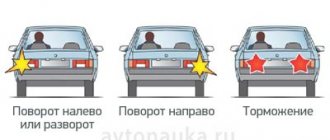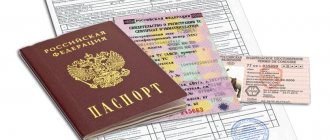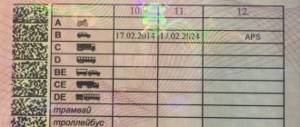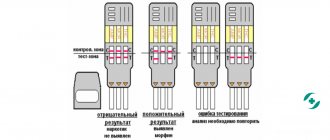Responsibility for running red
If this offense is committed repeatedly, then the driver, in accordance with Part 3 of the same article, entered into force on July 23, 2013, will face a much more severe administrative penalty:
- Paying a larger amount for driving through a red light - a fine of 5,000 rubles;
- Deprivation of driver's license for a period of four months to six months.
Let us remind you that an offense will be considered a repeat offense if less than a year has passed since the payment of the fine for the previous violation.
However, in 2021, you can get a fine for running a red light by actually driving not through a prohibiting signal, but in the absence of a permitting signal, if the traffic light has additional sections in addition to the main one. So, if the green arrow in the add. section, then if you drive in the direction regulated by the latter, you will receive the same fine of 1000 rubles.
Interruption of railway tracks at a prohibitory signal
In addition to the cases described above, where drivers who have committed an offense for the first time can only receive a fine for a traffic light, there are others described in Part 1 of Art. 12.10 of the Code of Administrative Offences, namely crossing railway tracks at a prohibiting traffic light signal. In this case, the driver may face the following administrative penalties:
- payment of a fine of one thousand rubles,
- deprivation of rights from three months. up to six months.
You cannot cross the stop line at a signalized intersection.
Another offense that is closely related to the one described above is driving beyond the stop line at a signalized intersection. In Art. 12.12 also states that committing this offense at an intersection regulated by a traffic light or a traffic controller entails a fine less than the fine for a red light - only 800 rubles.
The stop line is indicated both by road markings and the corresponding road sign, and these elements can occur either separately or together. Let us remind you that their meanings do not coincide in everything:
- the sign obliges you to stop only at a controlled intersection, i.e. at a traffic light;
- The markings, in addition to stopping according to the requirements described above, instruct drivers to stop at uncontrolled intersections if there is an appropriate sign.
Do not enter an intersection if there is a traffic jam behind it.
As part of the material devoted to driving through a red light and the fine for it, it is worth considering such an offense as entering an intersection while a traffic jam has formed behind it. In this case, the motorist cannot leave this intersection while the traffic light is on, resulting in a traffic jam on each of the roads adjacent to the intersection. The fine for such an accident violation is also 1000 rubles.
In a word, you should not try to “fly through” the intersection; in general, you should be more careful on the road, because driving through an intersection with a prohibitory signal threatens not only a large fine, but also deprivation of your license if the violation is repeated.
Towing vehicles with automatic transmission
Rules for driving through railway crossings
Towing vehicles equipped with an automatic transmission is not recommended. When transporting a car with an automatic transmission in this way, the wheels of the car rotate, as a result of which some mechanisms inside the car begin to move. At the same time, the hydraulic pump that supplies oil to the engine does not function due to the fact that the engine is not running. Thus, when towing a car with an automatic transmission, there is a high risk of wear and failure of some engine parts.
Also, before carrying out such an operation, it is necessary to read the operating manual of the car that you plan to tow, since the design of some automatic transmissions requires additional precautions when towing
Forgetting to put the key in the ignition
There are 3 types of towing:
- On a flexible hitch using a cable (this is only permitted if the steering system and brakes are in good working order).
- On a rigid hitch using a steel rod or triangle. In the second case, a driver is not needed in the towed car.
- Partial loading (that is, the front or rear wheels are loaded onto a towing vehicle or a special platform).
One of the most common mistakes when towing a vehicle is that the driver forgets to put the key in the ignition. This applies only to those methods in which the presence of a driver in the towed car is not necessary. If it becomes necessary to tow your car, be sure to insert the key into the ignition. If this is not done, then when the steering wheel is rotated, the steering column lock will work, that is, the steering wheel will simply lock.
It should be borne in mind that when towing with the engine turned off, neither the hydraulic or electric power steering nor the brake boosters work, that is, it will be much more difficult to turn the steering wheel, and maximum effort will need to be applied when braking.
A little theory
What brands of cars are made in Japan
Axle load (axle load) is the load from the mass of the vehicle transmitted to the road surface by the wheels of one axle.
The mass of the vehicle (kerb or full) and the loads on its axles are related by a simple ratio:
Vehicle weight = front axle load + rear axle load.
The load on the rear axle of a vehicle is usually greater than on the front axle. This depends on the fact that the loading platform is located at the rear of the vehicle, and the load from the cabin and power unit comes from the front.
In front of the bridge or on certain sections of the road you can see prohibitory sign 3.12, which prohibits the movement of vehicles whose actual weight on any of the axles exceeds that indicated on the sign. If the axle load is greater than indicated on the sign, then the driver should go around this section of the road along a different route. Failure to comply with this rule is punishable by a fine.
Failure to comply with the requirements prescribed by road signs prohibiting the movement of vehicles whose total actual weight or axle load exceeds those indicated on the road sign, if the movement of such vehicles is carried out without special permission, entails the imposition of an administrative fine in the amount of five thousand rubles.
Article 12.21.1 part 11 of the Code of Administrative Offenses of the Russian Federation
When designing a car, the permissible axle load is used.
Permissible axle load is the permitted load transmitted to the road by the wheels of one vehicle axle.
There are established limits for permissible axle loads for two-axle vehicles:
| Distance between axles (m) | Permissible load on each axle for cars of group A | Permissible load on each axle for cars of group B |
| Over 2.00 | 10.0 | 6.0 |
| 1.65 – 2.00 | 9.0 | 5.7 |
| 1.35 – 1.65 | 8.0 | 5.5 |
| 1.00 – 1.35 | 7.0 | 5.0 |
| Until 1.00 | 6.0 | 4.5 |
Group “A” includes cars whose operation is permitted on roads of I-III categories, and group “B” whose operation is permitted on all roads.
Most people believe that overload increases braking distance. But in fact, it lengthens due to the inertia of the load, which also creates the conditions for the car to skid. And if the load is not secured, then there is a danger of tipping over and then other road users will also suffer.
Towing a car with automatic transmission and all-wheel drive
Traffic Laws
If the car has an automatic transmission, then towing it becomes more difficult. There are limitations for flexible or rigid coupling. The distance over which the car is transported should not exceed 50 kilometers, and the speed of movement should not exceed 50 km/h.
If the distance to the place of repair work exceeds the specified distance, then towing should be carried out using the partial loading method.
If the vehicle has four-wheel drive, then using the partial loading method is prohibited. There is also a transportation restriction imposed on him: 10 kilometers and a speed of no more than 30 km/h.
Features of vehicle preparation for towing
Towing a car is a standard situation, but it must be approached responsibly. Not every car can act as a towing vehicle. Before moving a disabled vehicle, it is necessary to assess the condition of both vehicles. First of all, weight is taken into account. As already said. It should be 1/2 times larger than that of the car being driven.
The towing vehicle must have a working brake system, steering, hazard warning lights and low and high beam headlights. The driven vehicle must have a working brake system, steering and hazard lights. If the hazard warning lights are faulty, it is permissible to mount a warning triangle in a visible place that does not interfere with visibility. Otherwise, it is recommended to use the full or partial loading method.
If the vehicle is being driven at night, both vehicles must turn on their side lights. If there is damage or complete absence of the windshield, then a motorcycle helmet is used for the driver of the driven vehicle.
To tow a car, a cable is used, the rated load of which is twice the weight of the towed car. The cable must be dry and clean. Its length varies from 4 to 6 meters. For reliability, the cable is attached to the car using carabiners or loops on a marine knot.
It is better to transfer all passengers to the leading car or send them to get to their destination on their own. The towed vehicle must have one driver.
If all towing rules are followed, the operation is carried out as normal and is not an emergency. It should be noted that foreign-made cars may have their own characteristics. You must carefully read the operating instructions. Some models cannot withstand towing with the gears engaged, the engine running, etc.
Is a category necessary?
The driver of a car that is pulling another vehicle on an inflexible device must be quite experienced. But one of the issues that worries motorists in connection with the concept of “rigid coupling” is the category of rights. Some people think that they should be with the letter E, allowing them to carry a trailer heavier than 750 kg.
More on AutoLex.Net:
We calculate correctly what pressure should be in the tires for a car or motorcycle, and how to change the pressure correctly
The definition of the difference between it and a car is in the traffic rules:
“Trailer” is a vehicle that is not equipped with an engine and is intended to be driven in conjunction with a power-driven vehicle.
A motor vehicle is a vehicle driven by an engine. the term also applies to any tractors and self-propelled machines.
Towing of cars is regulated by paragraph 20 of the traffic rules. It does not specify categories of rights. They are discussed in Article 25 of the Law “On Road Safety”. The legal document establishes a special category for each vehicle, as well as for the use of trailers with them. There is no mention of towing here.
It is clear from the traffic rules that a trailer and a car that has lost the ability to move under its own power are different types of vehicles. The law that exists for the use of the former does not apply to the latter. And in order to tow a car, the driver does not need to have the letter E on his license.
Government Decree No. 333 of March 24, 2017 contains a clarification regarding the length of service of a motorist:
When towing, driving towing vehicles must be carried out by drivers who have been licensed to drive vehicles for 2 years or more.
Situations when towing is not permissible
It should be noted that to move the car to the repair site, the operation of the alarm system and the cable is not enough. There are situations in which towing vehicles is not permitted.
- Towing is prohibited if the brake system breaks down for vehicles whose weight exceeds half the weight of the towing vehicle.
- In case of bad weather conditions (heavy rain, ice, poor visibility), towing with a flexible hitch is prohibited.
- Passing vehicles is prohibited if there is no visibility through the windshield.
- Towing is not permitted if the total length of the connected vehicles is more than 22 meters.
- It is prohibited to tow motorcycles without trailers or sidecars, mopeds and bicycles.
- Driving vehicles with trailers, vehicles in combination, or convoys is not allowed.
- In case of faulty steering, partial or full loading method is allowed.
Thus, towing a car - the rules and advice say that as a leading car you should choose one that is twice your weight. In this case, clutch in the form of a cable is allowed only in case of good visibility, weather, operation of the steering and brakes.
Basic rules governing the operation of a rigid hitch
All trailers without exception must have a rigid coupling option with the towing vehicle. The use of soft options is only available if the towed car has a working brake and steering system. All these features are enshrined in the traffic rules. If you come up with the opportunity to transport a trailer on a soft hitch, you will receive a good fine at the next traffic police station. Also, a rigid hitch is used in cases where the towed vehicle has a malfunction in the braking system or steering; operation and towing on a soft rope can be dangerous. The main features of safe towing with a rigid hitch are as follows:
- the towed car does not have a chance to drive into the tow, since the rigid coupling provides a certain distance;
- the hitch bar itself (it can be single or double) must be painted in a bright color or marked with signal flags;
- towing with such a stretch ensures that the towed vehicle is given the direction of movement of the tow;
- the illumination rules remain the same - the front car turns on the low beam headlights, and the rear one turns on the hazard warning lights;
- towing is possible at speeds of up to 50 kilometers per hour, if we are talking about two cars;
- in fact, you should not exceed the speed limit within 40 kilometers per hour - it turns out to be safer.
There are also many subtleties that relate to commercial vehicles or cars damaged in different versions. The best conclusion to draw is this: if you are going to tow a car damaged in an accident, you should use a rigid hitch. This will help you avoid potential problems and give you a better chance of getting to your destination safely. It is important to use only confident speed limits and avoid sudden movements both in the tow vehicle and in the driven vehicle. To understand the nature of towing, we should talk about the functional side of the issue.
Check weighing
Why is control weighing performed and how does it happen? Weighing is carried out in order to find out how much weight falls on each of the axles. After all, overload is a violation that entails a fine for overload on the axles.
There are two types of weighing - dynamic and static.
Dynamic weighing
is carried out without stopping the vehicle, but the vehicle speed should be no more than 5 km/h. For this weight measurement, axle car scales are used, which determine the weight of each axle, and then record the actual weight of the car. But this type of weighing has many disadvantages, one of which is the existing error, it can range from 0.5% to 3%.
Statistical Weighting
be carried out only after the vehicle has come to a complete stop. This type of weight measurement is quite accurate and is more suitable for commercial weighing.
Unified traffic rules for towing vehicles
It is customary to identify common towing canons:
- If towing is carried out in the dark, the vehicles should have the lights turned on.
- Regardless of the time of day, optics must be activated on both vehicles: low beam lights, fog lights.
- It is prohibited to travel at speeds above 50 km/h.
- The towing rope should be kept taut at all times, otherwise it will easily break if there is an unexpected jerk. A towed vehicle can run over a cable that hangs to the ground.
- Between both cars, on a flexible hitch there should be from 4 to 6 meters, on a rigid hitch - no more than 4 meters.
The following traffic rules have been introduced for a towed vehicle:
- The car is distinguished by a warning triangle attached to the bumper.
- The key must be inserted into the lock, otherwise the steering wheel will lock and the car will become uncontrollable.
- On descents the driver must be very careful. When the cable sag, it should smoothly brake the car, preferably using the handbrake.
- When turning, the driver of the car must be careful and not hesitate during the maneuver, especially on a busy road, where any gap that forms can immediately cause another car to wedge in.
The following traffic rules have been introduced for a towing vehicle:
- It is not recommended to use engine braking when towing, and in general, press the pedal as little as possible. You need to quickly change gears on a towing car.
- During a forced stop or slowdown, the driver must give a “stop” or hand signal to the towed vehicle.
- When maneuvering, the driver must move along the maximum possible radius.
There are also a number of mandatory rules that limit towing:
- Towing with a flexible hitch on slippery road surfaces or during icy conditions in winter is strictly prohibited.
- It is not allowed to pull a car with a trailer or several vehicles at a time.
- It is punishable by law if the towed vehicle has damaged brakes and is heavier than the tractor.
- It is prohibited to pull mopeds and bicycles on a cable.
- Motorcycles may only be towed with a side trailer attached.
- Towing is punishable by law if it is carried out in poor visibility: fog, heavy rain.
- It is prohibited to tow a coupled vehicle whose length exceeds 22 meters.
Rules for cars and trucks
The method of transporting a car using a rigid structure must comply with certain conditions. They vary slightly depending on the type of vehicle being moved.
Are common
Rigid coupling makes the following rules mandatory:
- the driver must sit behind the wheel of the driven vehicle, except in cases where the device gives him the opportunity to drive along the trajectory of the leading vehicle when moving in a straight line;
- if a bus or trolleybus is towed, no passengers are left in it;
- when moving the truck, there should also be no people in the back;
- a rigid hitch for passenger cars is also used when there are passengers in the cabin;
- vehicle speed cannot be higher than 50 km/h;
- the structure itself must be brightly colored so that other road users can see it and not try to wedge themselves between the leading and driven vehicles;
- The vehicle being towed must have its hazard lights turned on or a sign posted.
More on AutoLex.Net:
New fine for lack of technical inspection in Russia - how much and when will it come into force?
If the car's steering does not work, this method cannot be used. And in case of damaged brakes, a rigid structure is allowed for use. But the mass of the towed vehicle must be less than the driving one. You can only drag one car, no more.
Distance
The distance between the towed person and the tow vehicle should be sufficient, but not too large. The distance on a rigid coupling is allowed up to 4 m. This is what makes movement safe. The driver of the leading car can see the road from the sides and behind in the mirrors. The one who sits behind the wheel of the follower retains the opportunity to stop in time and not collide with the vehicle in front. The road train does not block the road.
Length
The size of the device is selected in accordance with the requirement for the distance between vehicles. Since it cannot be more than 4 m, the length of the rigid coupling must also be less than this value. The total size of the base of the structure and the fastenings with which it clings to cars are taken into account.
Driver behavior
The traffic rules do not contain nuances that are necessary for successful towing. But experienced motorists know and use them:
- the route is chosen in advance;
- it should not have many problem areas (intersections, U-turns, highways, etc.);
- if it is a rigid hitch for trucks, it is better to drive at a speed of up to 40 km/h;
- you need to agree in advance what signals to communicate on the road if you need to stop and take other actions;
- no need to make sharp turns with the steering wheel;
- movement and maneuvers must be performed smoothly, especially acceleration and braking;
- It’s better not to use backward driving, and if you can’t do without it, then do it in concert.
It should also be taken into account that a rigid hitch is undesirable when you need to pull a car with an automatic gearbox. The equipment may develop additional malfunctions during the process. The likelihood of damage is even higher when using a car with an automatic transmission as a tow vehicle.
More on AutoLex.Net:
Rules for choosing summer tire tread
To learn how to properly tow a vehicle with a rigid hitch, watch this video:
Towing a car: tips for choosing a cable and its designation
In addition to knowing the situations in which it is permissible to move an idle vehicle, it is important to know the features of choosing a cable. According to the traffic rules, certain requirements are imposed on him
If flexible or rigid fastening is used, different lengths are provided for the cable. In the first case, it should not exceed 6 meters, in the second - 4. This is due to the need to maneuver on the road and take into account other road users. If the cable is too long, it will create an emergency situation and make it difficult for other cars to move.
If a flexible clutch is used for towing, then special flags or markers are placed on the cable. They have red stripes and are a danger signal. Markers are placed at a distance of one meter from each other.
A special rope is chosen as a towing rope, which is made of durable nylon material. It has steel carabiners at the ends that are attached to cars. For reliable fastening and protection during jerks, the hooks have springs. It should be taken into account that a forged stick differs from a light alloy stick in weight. It should be about 500 grams.
When choosing a cable, consider the weight of the vehicle. Usually the maximum permissible load is indicated on the packaging.










